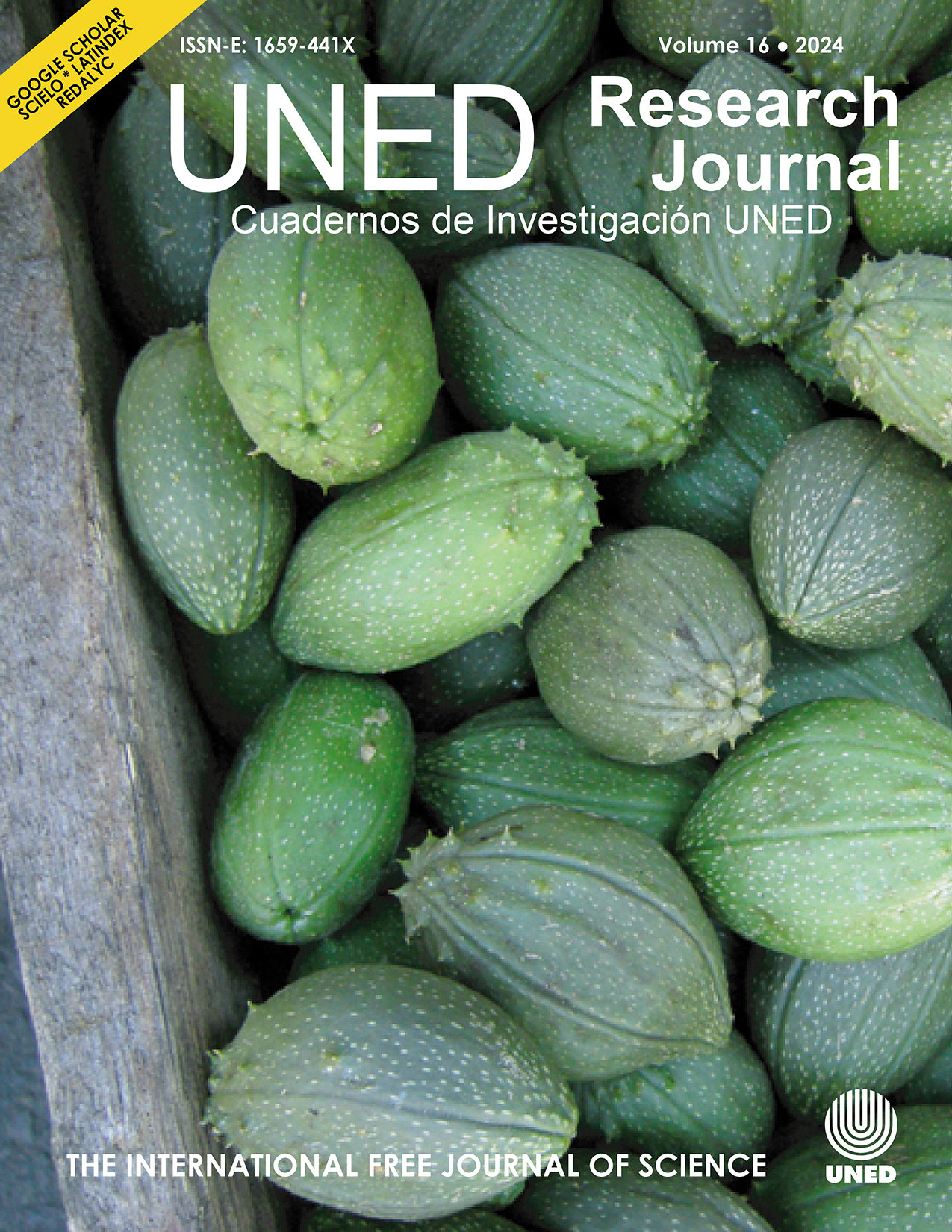Implementation of a high dose routine dosimetry in a self-shielded irradiator
DOI:
https://doi.org/10.22458/urj.v16i1.5229Keywords:
Red Perspex, calibration curve, PMMA dosimeters, high dose dosimetry, self-shielded irradiator, dose uncertaintyAbstract
Introduction: Ionizing radiation is applied in various fields, and dosimetric control guarantees the quality and safety of products during the irradiation process. There is a need for dosimetric calibration procedures in industrial irradiation plants, specifically for self-shielded irradiation systems. Objective: To implement high dose dosimetry in the routine control of irradiated materials within a self-shielded irradiator. Methods: We worked with 32 dosimeters; we divided the dose range used into 8 points and used four RED Perspex dosimeters per point. We measured the specific absorbance for each dosimeter; plotted these values against dose and produced a third-degree polynomial fit as a calibration curve. Results: We obtained the calibration curve with an r2 of 0,9997. The uncertainties due to the dispersion of the dosimeters and the calibration curve were 1,39% and 0,22%, respectively, for a total uncertainty of 4,80%. This uncertainty includes dose determination with a factor coverage (k) equal to 2 for a 95% confidence interval. Conclusion: Perspex RED dosimeters can be used for routine control of irradiated products in a self-shielded irradiator system.
References
Aquino, S., Lui, C. C., & Corrêa, B. (2017). Gamma Radiation Treatment Applied to Microbial Decontamination of Products Derived from Eggs Collected from the Retail Market in São Paulo. Arq. Bras. Med. Vet. e Zootec. 69, 1683–1692. http://dx.doi.org/10.1590/1678-4162-9241
Duarte-Ladeira, L., Zacarias-Mesquita A., & Tadeuy Pereira M. (2016). Calibrations of Perspex PMMA dosimeter in terms of absorbed dose to water for routine dosimetry at CDTN gamma irradiation laboratory. International Journal of Nuclear Energy Science and Technology, 9(3), 238-248. https://doi.org/10.1504/IJNEST.2015.074099
Eichholz, G. (2003). Dosimetry for Food Irradiation. Health Physics, 84(5), 665.
Farkas, J., & Mohácsi-Farkas, C. (2011). History and Future of Food Irradiation. Trends in Food Science & Technology, 22(2-3), 121–126. https://doi.org/10.1016/j.tifs.2010.04.002
Gujarati, D. N., & Porter, D. C. (2009). Basic Econometrics (5th ed.) McGraw-Hill Irwin.
Harwell dosimeters (2022, February 17). Harwell Red 4034 Dosimeters. https://www.harwell-dosimeters.co.uk/harwell-red-4034/
International Atomic Energy Agency (IAEA). (2005). Code of practice for the radiation sterilization of tissue allografts: Requirements for validation and routine control. Clinical Applications of Bone Allografts and Substitutes. 1–55, https://doi.org/10.1142/9789812701114_0001
International Atomic Energy Agency (IAEA). (2013). Guidelines for the Development, Validation and Routine Control of Industrial Radiation Processes. https://www.iaea.org/publications/8676
International Atomic Energy Agency (IAEA). (2017). Uses of Ionizing Radiation for Tangible Cultural Heritage Conservation. https://www.iaea.org/publications/10937
International Organization for Standardization (ISO). (2006). Sterilization of Health Care Products — Radiation — Part 1: Requirements for Development, Validation and Routine Control of a Sterilization Process for Medical Devices (ISO 11137-1:2006). https://www.iso.org/standard/33952.html
International Organization for Standardization (ISO). (2013a). Standard Practice for Calibration of Routine Dosimetry Systems for Radiation Processing (ISO/ASTM 51261:2013). https://www.iso.org/standard/60211.html
International Organization for Standardization (ISO). (2013b). Sterilization of Health Care Products — Radiation — Part 2: Establishing the Sterilization Dose (ISO 11137-2:2013). https://www.iso.org/standard/62442.html
International Organization for Standardization (ISO). (2017). Sterilization of Health Care Products — Radiation — Part 3: Guidance on dosimetric aspects of development, validation and routine control (ISO 11137-3:2017). https://www.iso.org/standard/63841.html
International Organization for Standardization (ISO). (2019) Practice for Use of a Polymethylmethacrylate Dosimetry System (ISO/ASTM 51276:2019). https://www.iso.org/standard/78276.html
International Organization for Standardization (ISO). (2020). Sterilization of Health Care Products — Radiation — Part 4: Guidance on Process Control (ISO/TS 11137-4:2020). https://www.iso.org/standard/69443.html
Joint Committee for Guides in Metrology (2008). Evaluation of Measurement Data—Guide to the Expression of Uncertainty in Measurement. https://www.bipm.org/en/committees/jc/jcgm/publications
Montgomery, D.C. (2012). Design and Analysis of Experiments (8th ed.) John Wiley & Sons, Ltd.
Sharpe, P., & Miller, A (2009). NPL Report CIRM 29: Guidelines for the calibration of routine dosimetry systems for use in radiation processing. Teddington: National Physical Laboratory. https://tinyurl.com/2dqhqolp
Whittaker, B., & Watts, M. F. (2001). The Influence of Dose Rate, Ambient Temperature and Time on the Radiation Response of Harwell PMMA Dosimeters. Radiation Physics and Chemistry, 60(1-2), 101–110. https://doi.org/10.1016/S0969-806X(00)00316-9
Published
How to Cite
Issue
Section
License
Copyright (c) 2024 Authors retain copyright and grant the journal right of first publication with the work simultaneously licensed under a Creative Commons Attribution License

This work is licensed under a Creative Commons Attribution 4.0 International License.
Note: This abstract contains an incorrect copyright due to technical issues. Authors who publish with this journal agree to the following terms: Authors retain copyright and grant the journal right of first publication with the work simultaneously licensed under a Creative Commons Attribution License that allows others to share the work with an acknowledgement of the work's authorship and initial publication in this journal
All journal contents are freely available through a CC BY 4.0 license.
CC BY 4.0 is a Creative Commons: you can copy, modify, distribute, and perform, even for commercial reasons, without asking permission, if you give appropriate credit.
Contents can be reproduced if the source and copyright are acknowledged according to the Open Access license CC BY 4.0. Self-storage in preprint servers and repositories is allowed for all versions. We encourage authors to publish raw data and data logs in public repositories and to include the links with all drafts so that reviewers and readers can consult them at any time.
The journal is financed by public funds via Universidad Estatal a Distancia and editorial independence and ethical compliance are guaranteed by the Board of Editors, UNED. We do not publish paid ads or receive funds from companies.
